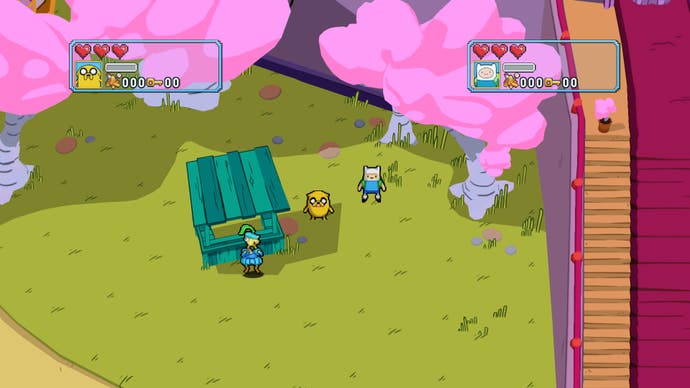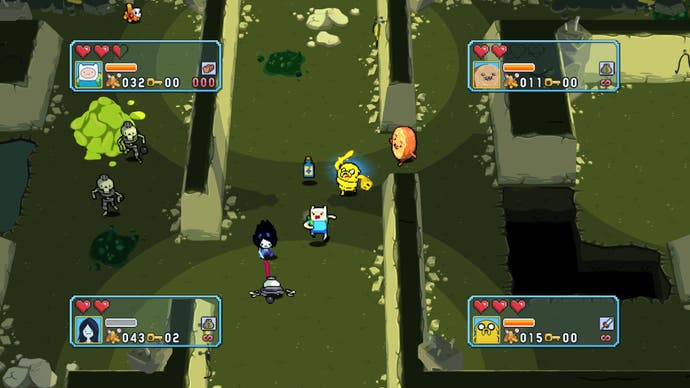Adventure Time: Explore the Dungeon Because I DON'T KNOW! review
Come on grab your friends. Or don't.
There are many words you could use to describe Cartoon Network's Adventure Time. Surreal. Inspired. Sweet. Ingenious. Sadly, those aren't words that apply to this video game spin-off. Repetitive. Shallow. Boring. These fit better.
If you've not had the pleasure of watching the TV show, then you've missed one of the greatest animated series of the last 20 years. A barmy fantasy pastiche starring Finn the Human and his rubbery, sardonic sidekick, Jake the Dog, it's set in the Land of Ooo, where pretty much anything is possible. Spewing from the mind of creator Pendleton Ward, it's a show that has the same sugar-rush stream of consciousness as a seven-year-old's imagination, tempered by the knowing sarcasm of adulthood.
It's a place where a bitter, lonely Ice King plots to kidnap an apparently endless stream of princesses, where Peppermint Butlers live in Candy Kingdoms, where lumpy space people talk like sedated Valley Girls and where there's nothing strange about a watermelon called Stanley having a family that consists of a pineapple, a pear, a banana and a string of sausages.
Stanley is in this game, as are dozens of other references to the surprisingly deep lore that has grown around the show, but references they remain. The game simply drapes an Adventure Time skin over established gameplay tropes, reflecting the source material without truly adapting it.

It is, as the title flippantly suggests, a dungeon crawler. Diablo is presumably the preferred reference point, but it actually goes further back than that: this is more a remake of four-player coin-op classic Gauntlet than a true RPG.
From a top down perspective, you and up to three local friends guide characters from the show through 100 floors, bashing enemies, smashing the objects that spawn them, opening chests and grabbing treasure. Every five levels, you're able to return to the hub outside and spend your loot on power-ups, secondary weapons and ability boosts, before delving back into the depths to carry on where you left off. Any treasure not spent is lost - a "Candy tax", apparently - so there's no way to save up for the long term.
There's certainly nothing wrong with the idea of a top-down, loot-grabbing roguelike - some of the best games of the last few years have drunk from that well - but the way it's been implemented here poorly serves both the arcade games and TV show that inspired it.
Levels are sparsely populated, and so never build up the momentum needed to sustain a 100-level adventure. Trudging around, looking for the stairs that lead to the next floor, occasionally battering a couple of enemies - it's inert, lifeless stuff, blighted by fuzzy hit boxes and stiff button responses. Tokens can be equipped to improve your abilities, and bonus weapons offer a minor change of pace from your standard button-bashing melee attacks, but there's nothing that pulls the game out of its comfortable rut. Each character builds up to a special move, but this again is nothing out of the ordinary and quickly becomes part of the gameplay wallpaper.

There are boss battles every 10 floors, but these too stick to familiar rhythms. When the game does make an exception, as on the 20th-floor challenge which finds you running away from a stampede of enemies, hitting switches to open the way ahead, the result is simply frustrating and fussy.
Vlambeer's Jan Willem Nijman gave a great interview to Rock Paper Shotgun last month on the importance of "feel" in game design. How the right sound effect, a few more pixels of movement, a minor tweak to the speed or number of enemies, can drastically alter the gameplay experience for the better. These are all things that are lacking here, as you explore just a little too slowly, deliver hits that feel a little too weightless, and find paltry scraps of loot in levels that are too large and empty to be interesting. The lack of energy is stultifying.
That would be a problem for any game, but for one based on such boundlessly exuberant source material, it's painfully noticeable. The TV show cast voices the characters, though many of the constantly repeated lines seem to be samples from the show rather than original recordings made for the game. Each boss stage leads to a short pixel-art cut-scene where some of the Adventure Time flavour soaks through, but during gameplay you could swap out the sprites and be playing a game based on any cartoon. From a show where anything can happen to a game where almost nothing happens; for fans, this will be the greatest disappointment.
"This is not even a particularly bad game, just a bland and unambitious one that feels like it escaped from a web browser and somehow found its way onto a disc"

The decision to present the game in a retro style throughout is an interesting one, but it fails to pay off. The sprites are flat and, frankly, more than a little lazy. Edges are smudged, details are smeary, and animations lack the loopy elastic quality that the show specialises in. The TV theme gets a nice chip tune rendition, but in-game, the music is generic noodling that suits the rest of the game only in its lack of character. The whole ultimately feels less like a deliberate tribute to a more innocent gaming era, and more like an actual mediocre licensed SNES game from 1993.
What's most frustrating is that with more enemies, more graceful control and a more compelling structure, there's no reason why a retro-styled Adventure Time roguelike couldn't have been an absolute treat and a game worthy of the show. Developer WayForward has certainly made better licensed games than this in the past. But then this is not even a particularly bad game, just a bland and unambitious one that feels like it escaped from a web browser and somehow found its way onto a disc. The wonderfully weird Land of Ooo and its eclectic inhabitants deserved so much more.

